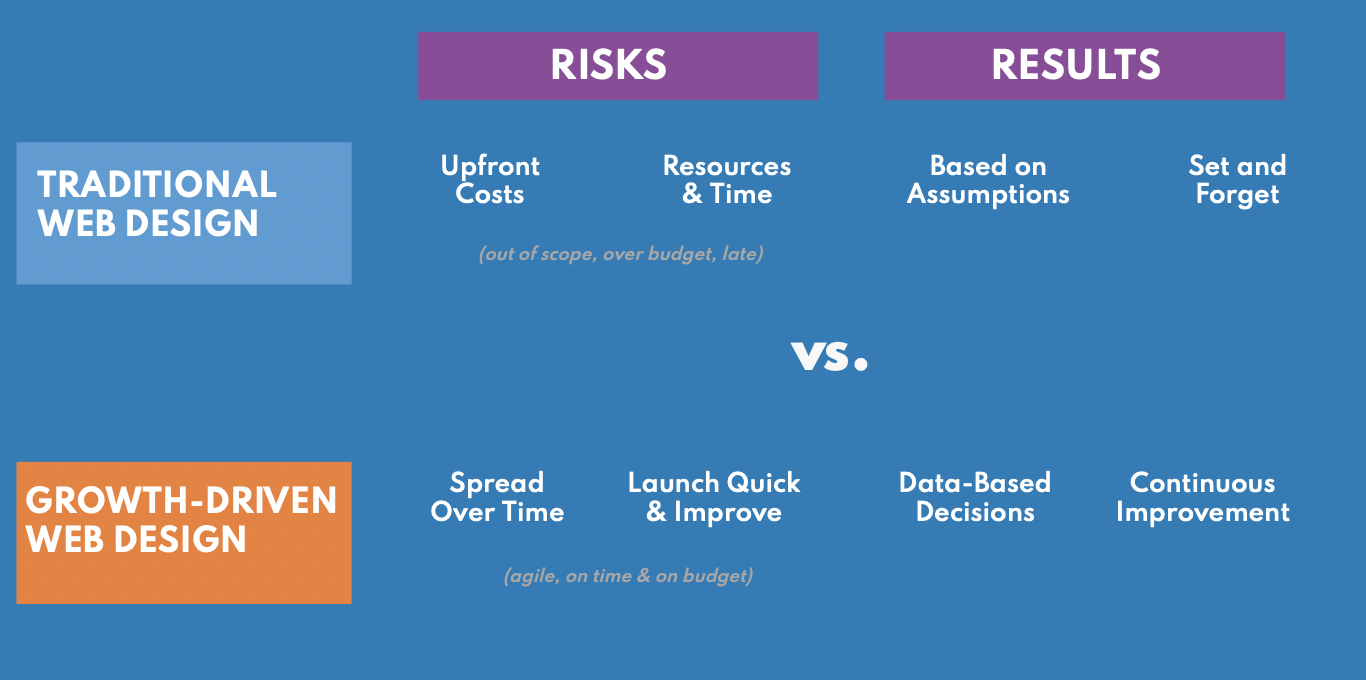Agile Web Design: Growth-Driven Design vs Traditional Web Design

The Current Landscape of Website Design
In this day and age, there’s an outstanding demand for brands to facilitate digital experiences that resonate with their audience. As a growth-driven design agency and HubSpot partner, O8's web development team works to craft this very type of agile customer experience that surprises and delights visitors, rather than steering them away.
No matter your unique set of needs or goals, a Growth-Driven Web Design methodology helps you evolve and stay relevant in an ever-changing digital landscape through continuous improvements and agile design informed by real-user behavior and insights.
Traditional Website Design
Since the birth of the internet and the beginning of traditional website design as we know it, marketers and business owners have employed an approach of building, setting, and forgetting. While this process can work with other content or marketing assets, it’s more apparent than ever that applying this same process to web development projects is too risky and produces poor results when it comes to user experience.
Not to mention the high up-front costs, extended resources, and massive amounts of time required. Even after the initial launch, it can be unclear how the new design and improvements help. As a business owner, this can set you back, dedicating 3-6 months working on something that has no proof or data of returning success. All in all, traditional web design can bring about more stress and confusion than leaving things as they were.
Growth-Driven Website Design
A growth-driven design approach is not only a philosophy for building better websites; it is a well-defined design process that resolves the inefficiencies of traditional website building. Typically, crafting a website with this approach takes place in three stages. Businesses working with O8 to transition away from substantial redesign projects toward continuous learning and enhancement of a new site will experience these stages up close.

GDD Stage 1: Strategy
The strategy phase involves gathering data about what works and doesn't work with your current website. Developing an empathetic understanding of your audience's world and how the website can solve their problems along that journey helps solidify fundamental assumptions aligned to your global strategy, business, and website goals.
At this stage, the O8 team works with you to understand the different personas that your design and content should appeal to most, setting goals to achieve the desired outcome. These insights and metrics are then used to create a wishlist of site elements, pages, and other SEO and content tasks to implement on your launch pad website, laying the foundation for step two.
GDD Stage 2: Launch Pad (Minimum Viable Product)
With a solid digital marketing strategy and deeper understanding of your target audience in hand, stage two involves developing a new launchpad using a wishlist of high-impact to incorporate. A launchpad is a website built to capture data that looks and performs better than the one you have today. It’s not fully featured but is strategically built to help you grow, focusing on central improvements and elements defined during the strategy stage. After it goes live, your launchpad site starts attracting users and generating data that will validate your strategy decisions upfront.
As an experienced partner agency, we help guide your website redesign approach, accelerating the process through sprint workshops and periods of ideation, problem-solving, prototyping, and testing that allows your team to share knowledge and develop new ideas.
GDD Stage 3: Continuous Improvements
Once the live launchpad site starts collecting user data, you can start identifying high-impact actions you can take to grow your business and make continual improvements. What makes this a smarter approach is the fact your new website becomes an evolving tool that transforms over time to meet changing customers‘ needs and preferences.
Instead of pushing through a process based on assumptions, you capture real value as you build by observing how visitors interact with the new website. Here is where the major difference lies between traditional and growth-driven design. The process to align and execute these continued improvements follows a repeatable four step process that works to make agile and real-time adjustments.
These steps include:
- Planning: Determining impactful items and areas of focus to build or optimize.
- Building: Working in sprints with a cross-functional team to complete high-impact action items.
- Learning: Reviewing the experiments you’ve run to extract learnings about your audience.
- Transferring: Sharing these learnings with stakeholders and throughout the entire company to improve the entire system, not just one of its parts.
All in all, this three-stage GDD process reduces the frustration and headache of building a website and inbound marketing strategy that drives optimal results using real user- data which improves the entire company.
More than that it adds real value by making music out of the noise. Messy websites miss out on valuable data that impacts growth in other ways that GDD captures by systemically capturing and implementing insights that matter the most.
Curious about your website's current performance?
Comparing Growth-Driven Web Design vs Traditional Web Design
Traditional Web Design:
- Full-scale-top to-bottom approach
- Striving for optimal results
- Fully-built single-stage templates
- 12-16 weeks to launch
Growth-Driven Design:
- Retainer engagement post-launch for continuous web and marketing improvements.
- Launchpad website (minimum viable product)
- Sprint workshops and continual development process optimizations.
- 6-8 weeks to launch.
Growth-Driven Web Design vs Traditional Web Design: Risks and Results

Partnering with a Growth-Driven Design Agency
With a proven record of success as a Growth-Driven Design Agency and the data to back up those claims, we launch websites that are tailored to your niche and informed by user data.
After more than a decade in the industry, we’ve witnessed the birth and adoption of new technology and platforms, staying ahead of the curve the whole way by implementing growth-driven design methodologies and others alike.
As a result, the value of partnering with a Growth-Driven Design Agency like O8 lies in four key areas:
Iterative GDD Principles: An O8-developed website redesign based on GDD principles is iterative—created for easy and frequent modification over time. These sites are dynamic and robust, not static and flat, corresponding to demanding user expectations on the modern web.
Thorough Website Audits: Starting with a thorough assessment of your existing website, O8's cutting-edge web developers and design team develop a clear strategy for a better approach that will allow for rapid continuous improvements. No matter your industry vertical or the buyer personas you need to target, we can produce measurable success.
Customized Design Projects: We make sure our website redesign services are an excellent fit for your business, with an engagement model that considers the holistic needs of your business and its work in digital spaces. Our flexibility translates into value.
Scaleable Service Model: Our team knows that no two businesses have identical needs, so we offer services that scale to match your needs. From the insight of a solo developer to an entire design team dedicated to implementing the GDD process at full scale, we adapt to suit the role you require.
Evolve your web presence and leave static design behind.
Conclusion
Escape the headache of website redesign projects and enter into a world of continuous innovation and ease informed by real-user behavior with O8. Get in touch for more information on how your bunniess can transition from traditional website design to growth-driven website design and make agile improvements today. With GDD, your next website redesign could be your last.

